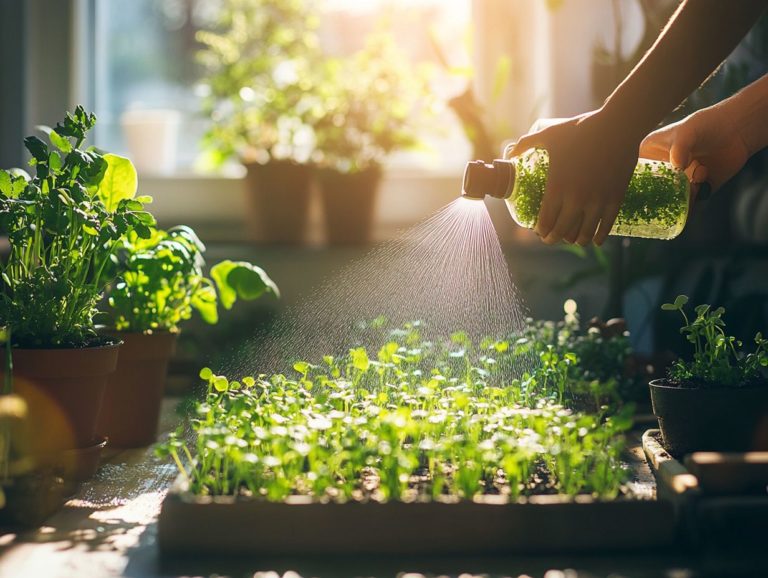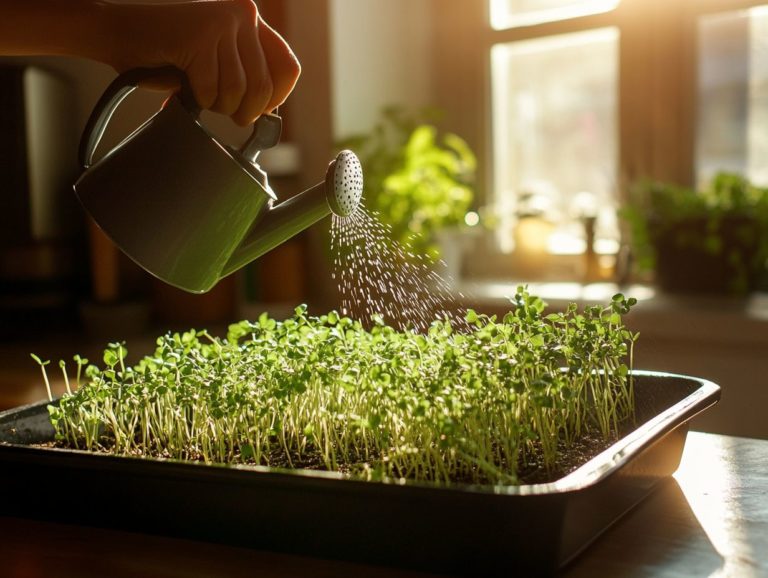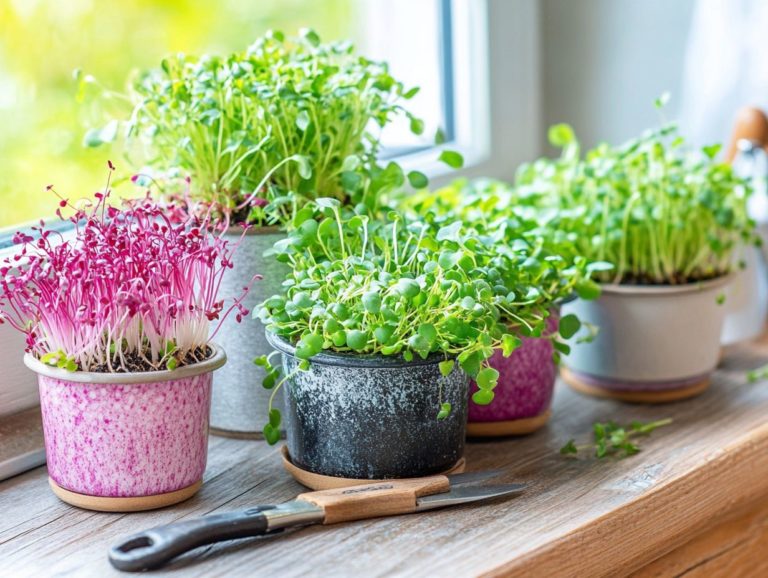How to Extend the Growing Season for Microgreens
Microgreens have captured the attention of the culinary elite, admired not only for their vibrant flavors but also for their remarkable nutritional benefits. Let s dive into the vibrant world of microgreens!
This exploration delves into what microgreens are and offers insights on maximizing their potential by extending the growing season. You ll uncover the environmental factors that influence their growth, various techniques for both indoor and outdoor cultivation, and essential tips for achieving successful year-round production. You can also discover how technology can enhance your microgreen farming efforts.
Contents
- Key Takeaways:
- What are Microgreens?
- Extending the Growing Season
- Factors Affecting Microgreen Growth
- Methods for Extending the Growing Season
- Tips for Successful Year-Round Microgreen Production
- Using Technology for Extended Growing Seasons
- Frequently Asked Questions
- What are microgreens?
- Why would I want to extend the growing season for microgreens?
- How can I extend the growing season for microgreens?
- What is a cold frame and how does it help extend the growing season for microgreens?
- Can I use a grow light to extend the growing season for microgreens?
- Are there any other tips for extending the growing season for microgreens?
Key Takeaways:
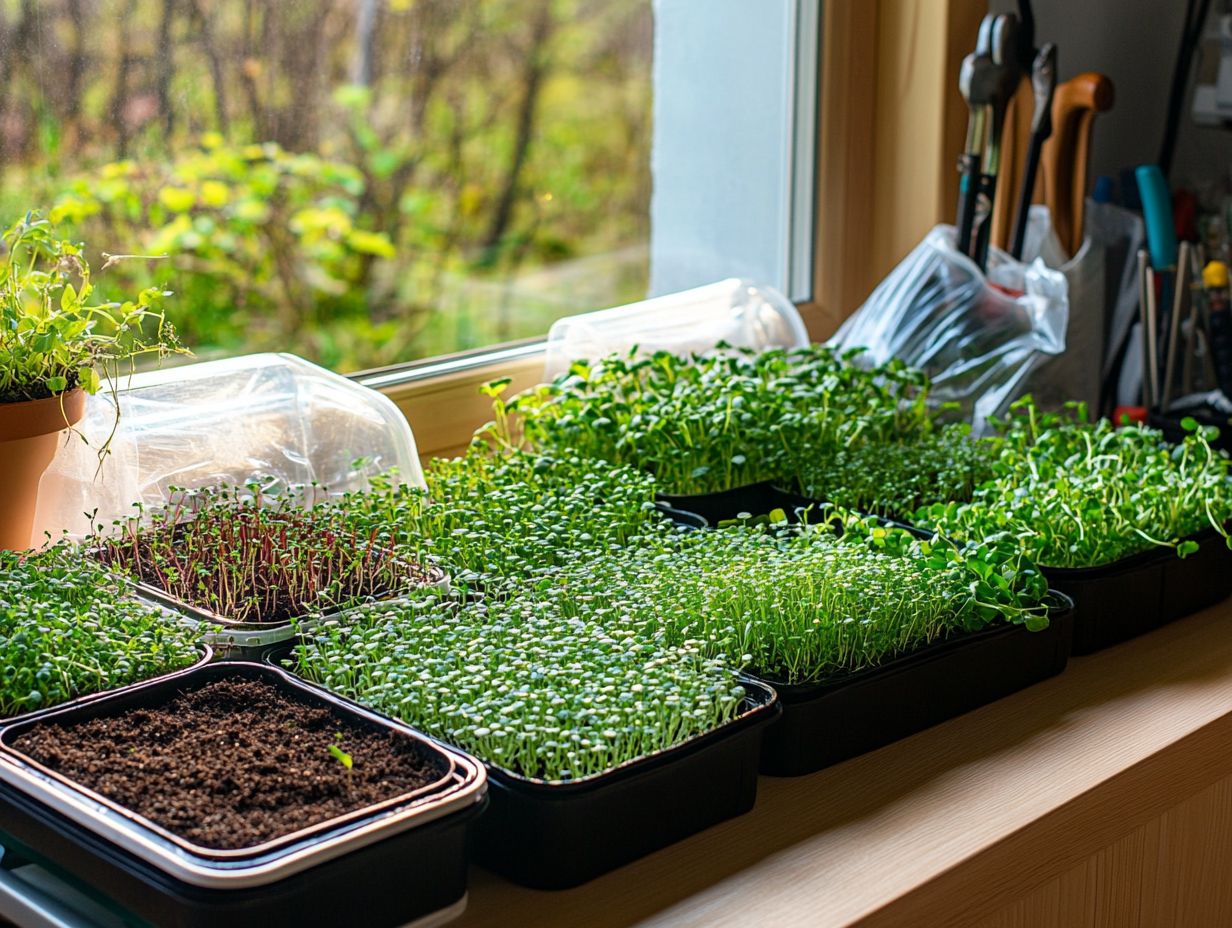
- Microgreens are nutrient-rich, young plants that offer numerous health benefits, including essential vitamins and antioxidants.
- Extending the growing season for microgreens allows for year-round production, increasing availability and freshness of these superfoods.
- Factors such as proper environmental conditions and utilizing indoor/outdoor growing techniques can help successfully extend the growing season for microgreens.
What are Microgreens?
Microgreens are young, edible plants that you can harvest right after the first true leaves appear, delivering a delightful punch of flavor and a treasure trove of nutrients, including vitamins, minerals, and antioxidants.
Varieties like broccoli sprouts, kale, arugula, and radish not only tantalize your taste buds but also pack a serious health punch.
As nutrient-dense additions to your meals, microgreens have become increasingly popular in indoor and sustainable gardening, making it easier for you to grow fresh greens at home for salads and Buddha Bowls.
Definition and Benefits
Microgreens are essentially the young seedlings of edible vegetables and herbs, harvested just after germination, and brimming with heart-healthy vitamins and antioxidants.
These tiny powerhouses are not only a feast for the eyes but also deliver a concentrated dose of nutrients that can elevate your diet significantly. By incorporating microgreens into your meals, you can support weight management, gaining a multitude of vitamins and minerals while keeping calories in check.
Take broccoli sprouts, for instance; they are remarkable for their high sulforaphane, a natural compound found in broccoli that may help detoxify the body and is associated with cancer prevention. Understanding the myriad health benefits tied to these vibrant greens might just inspire you to toss them into your salads, sandwiches, or smoothies, enriching your overall nutrient intake with every bite.
Extending the Growing Season
Extending the growing season for microgreens is an essential strategy in sustainable gardening, which refers to gardening practices that are environmentally friendly and promote long-term health. This strategy enables you to savor fresh, nutrient-dense greens throughout the year, no matter the whims of the weather.
By embracing a range of gardening techniques, including indoor cultivation and the use of greenhouses, you can significantly enhance your microgreens yield, even when the temperatures drop. Consider exploring How to Use Hydroponics for Microgreens to maximize your results.
Benefits of Extending the Season
Extending the growing season for microgreens offers a wealth of benefits, from a continuous supply of fresh, nutrient-rich greens to a significant boost in your healthy eating and sustainable gardening efforts. This ongoing availability not only enhances the nutritional profile of your meals but also allows for better flavor development, elevating your dishes, whether it s a crisp salad or a vibrant Buddha Bowl.
By incorporating these colorful greens into your diet, you can savor a burst of freshness and essential vitamins that support your overall well-being. An extended growing period means more opportunities for harvesting, making it easier for you to integrate a variety of microgreens into your culinary creations.
These tiny powerhouses can truly transform any meal, ensuring that health benefits take center stage while providing a delicious and satisfying dining experience.
Start growing your own microgreens today to enjoy health and flavor in every bite!
Factors Affecting Microgreen Growth
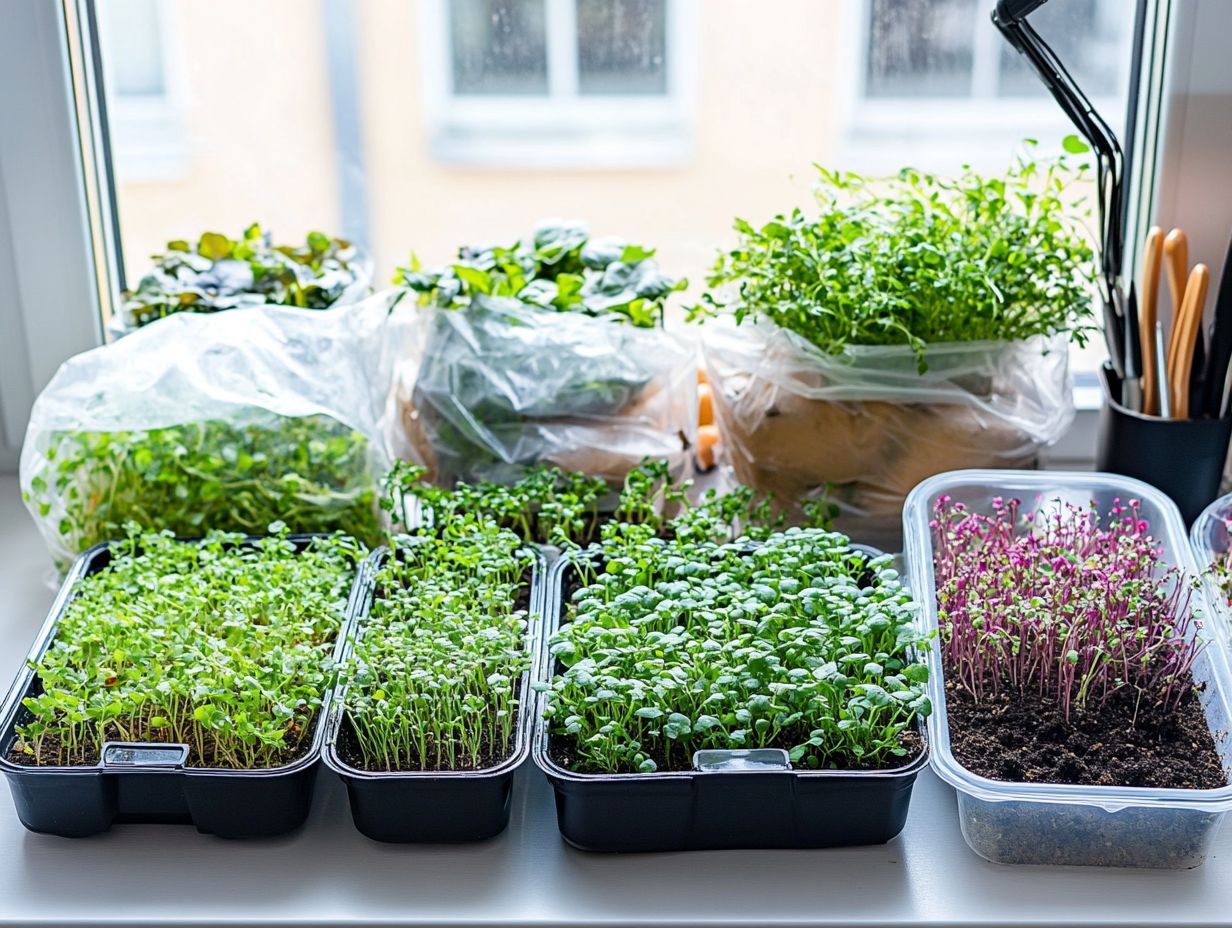
Several factors influence the growth of microgreens, including environmental conditions like soil quality, light exposure, and the nutrients available to the plants. Understanding these elements is essential for you as a grower aiming to optimize your microgreens cultivation, whether you choose to use special mats designed for planting seeds or traditional soil methods for sprouting seeds.
Environmental Conditions and Techniques
Environmental conditions are important for the successful growth of microgreens. Factors like light, soil type, and nutrient availability significantly influence their health and yield.
These young plants typically require around 12 to 16 hours of bright, indirect light each day. Place them near a window or invest in grow lights that mimic natural sunlight.
The soil you choose is crucial. A nutrient-rich and well-draining mix leads to strong roots and healthy plants. For the best results, experiment with different soil blends, perhaps combining compost with coconut coir to create textures that cater to specific microgreen varieties.
By maintaining consistent moisture levels and ensuring good air circulation, you can effortlessly cultivate a vibrant and abundant microgreen garden.
Methods for Extending the Growing Season
To maximize the growing season of microgreens, utilize a range of both indoor and outdoor techniques. These methods enable you to enjoy fresh, flavorful greens no matter the climate outside.
Indoor Growing Techniques
Indoor growing techniques for microgreens offer a fantastic solution for year-round cultivation. Use controlled lighting and specialized growing mats to guarantee optimal growth.
This method allows you to fine-tune light intensity and duration, creating an environment that beautifully mimics the natural sunlight cycle. Adjusting these elements encourages quicker germination and produces crops with vibrant colors.
Keeping moisture levels in check is easy with humidity domes and self-watering trays, which help prevent over or under-watering.
Using eco-friendly tools like LED grow lights boosts energy efficiency and supports sustainable gardening practices that minimize your environmental footprint. This approach enables you to grow nutritious greens at home while protecting the planet.
Outdoor Growing Techniques
Outdoor growing techniques for microgreens involve harnessing natural light and enriching the soil to achieve vibrant growth and a bountiful harvest. Techniques from experts like Johnny Seeds and Botanical Interests can be very helpful.
Understanding how to position your crops to maximize sunlight exposure is crucial. Varying light intensity significantly impacts growth rates. Managing soil health through regular amendments ensures essential nutrients are readily available for optimal development.
Implementing crop rotation enhances soil vitality and prevents disease buildup. Don’t forget to consider seasonal changes! During cooler months, use transparent covers to trap warmth and light, creating a nurturing environment for your microgreens. If you’re looking for efficient methods, check out this guide on how to grow microgreens in a small space. In hotter periods, shading techniques will protect those delicate shoots from scorching, allowing for success in cultivation throughout the entire year.
Tips for Successful Year-Round Microgreen Production
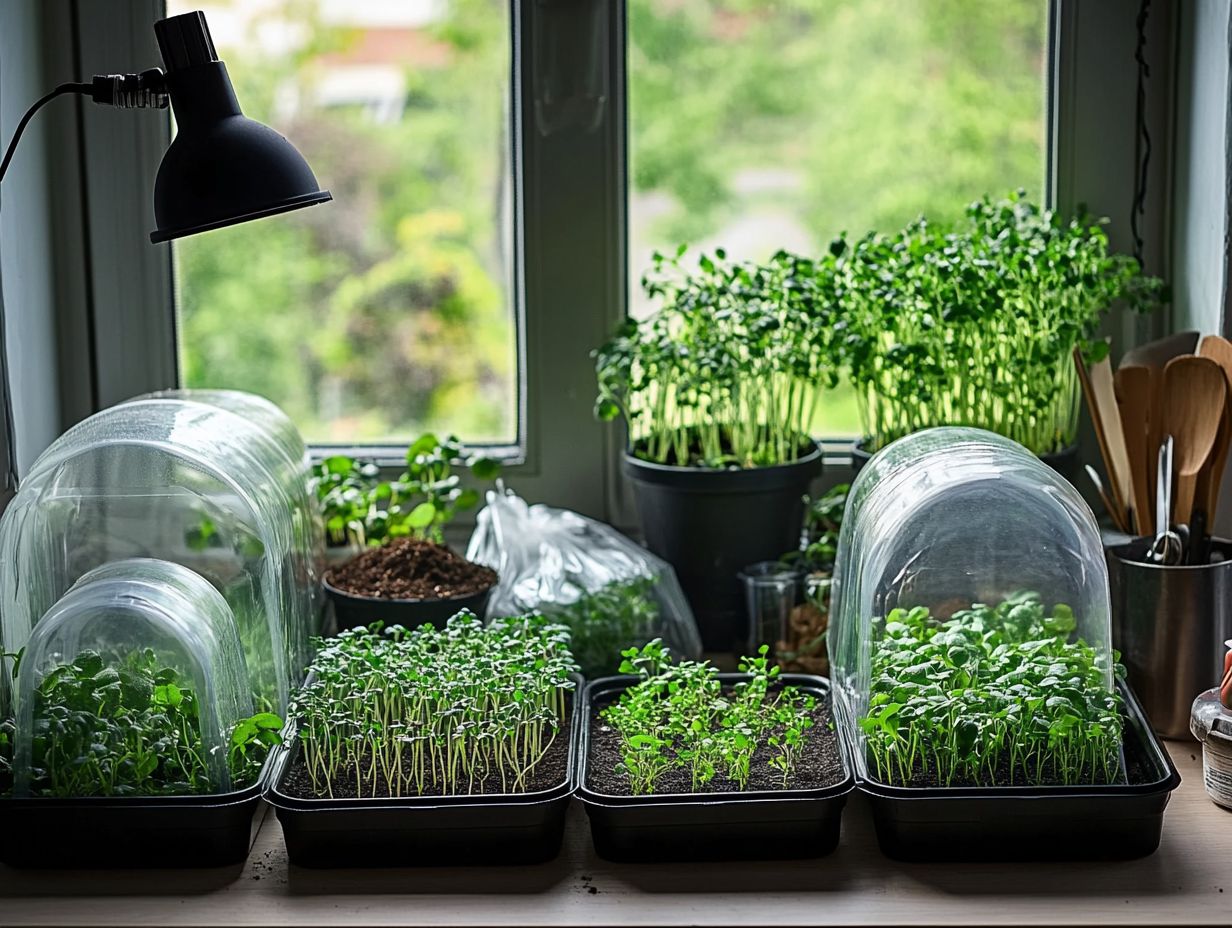
Achieving successful year-round microgreen production demands your keen attention to detail and a commitment to best practices. Stay vigilant about common mistakes that could impede the growth of these nutrient-rich greens.
By cultivating this awareness, you can elevate your microgreen endeavors to new heights. Get ready to enjoy fresh greens all year round!
Best Practices and Common Mistakes to Avoid
Implementing best practices for microgreen production can significantly enhance your growth, whether you are growing indoors or outdoors while being mindful of common mistakes can save you valuable time and resources.
To maximize your yield, pay close attention to soil management. Ensure that your medium retains moisture yet provides adequate drainage. A balanced nutrient mix is essential, as these delicate greens thrive on the right levels of sunlight, water, and nutrients. For a comprehensive approach, refer to this step-by-step guide to sowing microgreens. Using high-quality growing mats makes it easier to harvest and promotes healthier root development.
Common pitfalls include overcrowding seeds and neglecting to monitor moisture levels. By taking proactive steps such as thinning seedlings and regularly checking soil dampness, you can cultivate a thriving microgreen garden that delights both novice and seasoned growers alike. To ensure your microgreens thrive, it’s also important to understand the perfect light conditions for microgreens.
Using Technology for Extended Growing Seasons
Embracing technology for extended growing seasons has transformed the world of microgreen cultivation. It equips you with sophisticated tools and resources, such as smart sensors, that not only boost efficiency and yield but also guarantee optimal growth conditions. Don’t miss out!
Tools and Resources for Efficient Production
The right tools and resources can significantly enhance your microgreen production efficiency, whether it’s specialized growing mats or advanced indoor gardening systems crafted for optimal growth.
Consider high-quality grow lights; they can effortlessly simulate perfect sunlight conditions, speeding up germination and boosting your yields. Regarding soil alternatives, options like coconut coir or peat moss excel at providing excellent drainage and moisture retention, which is essential for developing robust root systems.
Implementing seed trays with drainage holes is another smart move to prevent waterlogging, ensuring your microgreens thrive in their environment. Incorporate nutrient-rich fertilizers to elevate both flavor and nutrient content of your plants, resulting in healthier growth overall.
By utilizing these tools and resources, you can streamline your production process while embracing sustainable practices that benefit both the environment and the end consumer.
Frequently Asked Questions
What are microgreens?

Microgreens are young vegetable and herb plants that are harvested just after the first set of true leaves develop, which are the second set of leaves that appear after the initial seed leaves. They are known for their intense flavor and nutritional value.
Why would I want to extend the growing season for microgreens?
Extending the growing season for microgreens allows you to have a continuous supply of fresh, nutrient-rich greens throughout the year, even in colder climates. This is great for growing broccoli sprouts and other varieties packed with vitamins and antioxidants.
How can I extend the growing season for microgreens?
There are a few methods you can use to extend the growing season for microgreens, such as using a cold frame, a grow tent, or a greenhouse. These structures protect your plants from harsh weather and allow you to control the temperature and light conditions.
What is a cold frame and how does it help extend the growing season for microgreens?
A cold frame is a simple structure made of transparent material, such as glass or plastic, that acts as a mini greenhouse. It traps heat and moisture, creating a microclimate that is warmer than the outside temperature. This technique extends the growing season for microgreens by protecting them from frost and cold temperatures.
Can I use a grow light to extend the growing season for microgreens?
Yes, using a grow light is an effective way to extend the growing season for microgreens. It provides consistent light and temperature, which are essential for growth.
Use full-spectrum grow lights, which mimic natural sunlight. Adjust their height and exposure time based on the needs of each microgreen variety. This is important for the best flavor and nutrients.
Are there any other tips for extending the growing season for microgreens?
Yes! Try using mulch and row covers to protect your plants. These methods can make a real difference!
Choose cold-tolerant microgreen varieties and plant them in a sheltered area to help extend the growing season.


